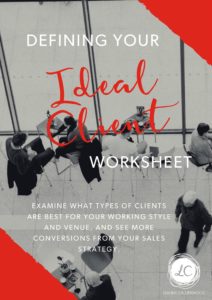“Send me a DM!” It sounds so casual. So friendly. So... easy. But for most…

Defining Your Ideal Client
(this is an update to the original post of September 2019 – includes updates as they pertain to post COVID19 sales and facility/service considerations)
When I first started in meetings’ site selection, I became a prospecting fiend! I did not come from hotel sales, so learning how to sell was my first priority. And BOY, did I make a ton of mistakes those first few years. I tried to fill my pipeline with as many potential clients as possible, and build my business as quickly as possible.
I didn’t understand the concept of defining my service for any particular type of planner or type of meeting. I saw success in the “shooting fish in a barrel method”, but I also saw a number of challenges in trying to “be all things to all people.”
It’s a common sales pitfall, especially among new salespeople who want to impress their bosses and colleagues with closing as many deals as possible. What can complicate matters, even more, is the push to take ANY business in light of a buyer’s market.
One of the most powerful tools in every salesperson’s toolbox is a good understanding of their ideal client profile. Knowing who you serve best may help fill your business with the RIGHT type of clients versus ANY type of client.
A word about MARKETS – many of you work a certain market in the industry – be it corporate, association, SMERF, incentive, business travel etc. We’re going to look at how to best serve your MARKET in an upcoming post – this post is about working WITHIN your market.
How do you define your ideal client?
By asking some of the below questions, you will be able to determine the client type that you can work best with, and respectively best exercise both your sets of strengths to develop the ideal client relationship. This includes post-COVID19 meeting considerations as well.
Remember, any answers to these questions do not pigeon-hole you into not accepting or prospecting business from other types of planners; this exercise merely helps you create a profile in your mind, and when you create sales materials/pitches/value-adds, you have this ideal client as top of mind in each thing you create and deliver.
- What are the demographics of your ideal client – items can include things like:
- Gender – Your working style may be a better fit for male clients who like your no-nonsense approach to business, or perhaps more relational style typical of female clients.
- Age – Perhaps you like working the younger generations; their way of decision-making is different from Gen Xers and Boomers.
- Job Title – You may prefer working with the top decision-maker, or you may have more influence on those in an administrative role.
- Job responsibilities – You may work better with those with lots of authority and decision-making ability, or you may thrive in a coaching environment where you provide more training and teaching moments to your potential clients
- Hobbies – If you share some similar hobbies, you can build rapport and trust faster with those individuals. In my field of site selection, my colleague has a daughter in dance lessons, so prospecting other dance groups is a natural fit.
- ⭐Current clients -what are the demographics of your top 5-10 clients? Are there any synergies?
- What are some of the characteristics of the clients you enjoy working with right now? What values and personality traits do they possess?
-
-
- Personality type – If you are an introvert, you may find working with extroverts to be exhausting. The opposite can be true if you are an extrovert and like to be friendly with your clients – you may find people who are “all business” to be standoffish.
- Working style – If you have an aggressive sales style, you may find working with clients who are passive to be very frustrating. Conversely, clients that are “all business” may not resonate with you if have a more laid-back approach to sales.
- Ethics – Perhaps you value ethics above all else, and finding clients that are ok with “bending the rules” would make you feel uncomfortable. What do you value, and what are “deal breakers” for the clients you serve?
- ⭐Current clients – what are the characteristics of your top 5 clients? Are there any synergies?
-
- What values will you not compromise to make a client happy? I call these the deal-breakers. These are things you will not compromise on, no matter the paycheck at the end of the day. For me, meeting planner clients that blatantly disrespect our supplier partners because they feel entitled to the supplier’s services is a big “no” in my book. I prefer to build my business with planners who believe in the team effort and collaboration required to make a program successful.
- What does the ideal meeting/conference look like for your facility/service? If you are a supplier to the meetings industry, defining your ideal client in terms of the program size or specs will also help tailor your prospecting. I’ve heard many hotel salespeople answer the following questions, “what does your ideal group look like”, with “we’ll take it all.” This does not give me reassurance that your venue will be a good fit for my programs if you are not sure who you can serve best. Be realistic about your venue and the type of business you can realistically book:
- venue size – maximum capacity in the largest ballroom
- venue’s ratings – high-end groups versus budget-conscious groups
- location – amenities onsite or nearby
- ⭐ability to host physically-distanced meetings – your ideal program may look quite different if physical distancing is required!
- ⭐ability to host safe and clean meetings
- ⭐what are the common characteristics of your top 5-10 client programs?
- What strengths does your ideal client possess? How are they different from your own? By finding clients that complement us, we create a true partnership in sales, one that will reap trust and translate into repeat business and referrals. If your clients are skilled at decision making but lack research skills, this is where you can truly partner to create an amicable sale. I thoroughly enjoy working with clients that are very savvy meeting planners. They can pull the details together like nobody’s business but may lack the contacts and buying power to make their jobs easier. I help them connect the dots and match them with resources that save them time, so they can be more strategic in their strengths and their work.
- ⭐What are the strengths of your top 5 current clients? Do they complement your own?
I’ve also created this handy worksheet to help you map out your ideal client profile – it’s yours free to use!
By going through this exercise, you will be able to spend your time more effectively working with clients that are ideal for your business. You’ll meet your goals faster and be happier with the business you’re building. Good luck!
RELATED – Hosting the Perfect FAM Trip (pre-covid19 edition)
RELATED – Researching Clients Via LinkedIn
Photo by Brooke Lark on Unsplash




